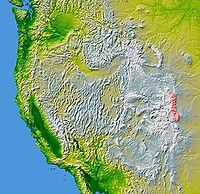Front Range
| Front Range | |
|---|---|

Front Range Peaks in the Indian Peaks Wilderness.
|
|
| Highest point | |
| Peak | Grays Peak |
| Elevation | 14,278 ft (4,352 m) |
| Coordinates | 39°38′02″N 105°49′01″W / 39.63389°N 105.81694°WCoordinates: 39°38′02″N 105°49′01″W / 39.63389°N 105.81694°W |
| Geography | |
|
The Front Range (excluding the Laramie Mountains) is shown highlighted on a map of the western U.S.
|
|
| Country | United States |
| States | Colorado and Wyoming |
| Parent range | Rocky Mountains |
The Front Range is a mountain range of the Southern Rocky Mountains of North America located in the central portion of the U.S. State of Colorado, and southeastern portion of the U.S. State of Wyoming. It is the first mountain range encountered moving west along the 40th parallel north across the Great Plains of North America. The Front Range runs north-south between Casper, Wyoming and Pueblo, Colorado and rises nearly 10,000 feet above the Great Plains. Longs Peak, Mount Evans, and Pikes Peak are its most prominent peaks, visible from the Interstate 25 corridor. The area is a popular destination for mountain biking, hiking, climbing, and camping during the warmer months and for skiing and snowboarding during winter. Millions of years ago the present-day Front Range was home to ancient mountain ranges, deserts, beaches, and even oceans.
The name "Front Range" is also applied to the Front Range Urban Corridor, the populated region of Colorado and Wyoming just east of the mountain range and extending from Cheyenne, Wyoming south to Pueblo, Colorado. This urban corridor benefits from the weather-moderating effect of the Front Range mountains, which help block prevailing storms.
About 1 billion years ago, the earth was producing massive amounts of molten rock that would one day amalgamate, drift together and combine, to ultimately form the continents we live on today. In the Colorado region, this molten rock spewed and cooled, forming what we now know as the Precambrian Pikes Peak Granite. Over the next 500 million years, little is known about changes in the sedimentation (sediment deposition) after the granite was produced. However, at about 500 – 300 million years ago, the region began to sink and sediments began to deposit in the newly formed accommodation space. Eroded granite produced sand particles that began to form strata, layers of sediment, in the sinking basin. Sedimentation would continue to take place until about 300 million years ago.
...
Wikipedia

